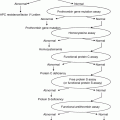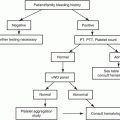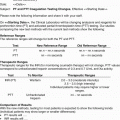Manufacturer
Instrument
Clot detection method
Compensation for interfering substances
Instrumentation laboratories
ACL series
Photo-optical
Interrogating wavelength
Siemens healthcare diagnostics
Sysmex series
Photo-optical
Blank measurement
BCS
Photo-optical
Blank measurement
Second wavelength
Diagnostica Stago
STA series
Mechanical
Not applicable
Destiny series
Mechanical or photo-optical
Mechanical mode
Mechanical detection methods employed in automated laboratory analyzers detect clot formation through changes in viscosity (movement of a metal ball), and are generally not considered to be susceptible to interference from colored solutes or suspended particles. However, it is worth noting that large concentrations (>3 g/dL) of dissolved hemoglobin, in the form of hemoglobin-based oxygen carriers, can cause artificial prolongation of clotting times when employing a mechanical-based detection method [1]. In addition, high concentrations of fibrin degradation products act to impede fibrin strand polymerization, and may result in falsely low fibrinogen measurements [2, 3].
3.2 Point of Care Instruments
Portable coagulation analyzers have been developed primarily to meet the need for whole blood monitoring of out-patient warfarin therapy (PT/INR) and moderate- to high-dose heparin anticoagulant management (ACT) during invasive procedures in the hospital setting. Over time, the manufacturers have extended the test menus of the professional instruments to encompass more of the routine coagulation assays available from the Laboratory (e.g., PTT, TT, fibrinogen, heparin). In addition, portable monitors that measure the viscoelastic properties of clot formation have been developed primarily for the management of intra-, and post-operative hemostasis. More recently, analyzers designed for platelet function analysis have entered the market and undergone clinical outcome trials.
3.2.1 Waived PT/INR Instruments
POC monitors intended primarily for warfarin management (Table 3.2) provide whole blood PT/INR testing, and are used primarily for clinic and home monitoring. PT/INR monitors employ unit-use reagent strips that contain thromboplastin reagents that are assigned an International Sensitivity Index (ISI) based on a comparison between a whole blood device and a reference plasma method. Theoretically, this indirect assignment (plasma to whole blood) could present difficulty in comparing results between plasma and whole blood tests using reagents with comparable ISI assignments. However, comparability is generally quite good when the ISI values are similar [4]. The preferred specimen type is fresh capillary whole blood, though untreated venous blood collected in a plastic syringe is also acceptable for some analyzers. These instruments detect clot formation through electrochemical (impedance) or mechanical (cessation of movement of iron particles; change in rate of blood/reagent mixture movement) methods (Table 3.2). Patients who have tested positive for a lupus anticoagulant should not be monitored with these devices due to the potential for interference with the test. In general, patients who are being treated with heparin should also not be monitored with these devices. However, the Roche Coaguchek assays incorporate heparinase into the test and can neutralize low dose heparin therapy.
Table 3.2
CLIA waived PT/INR monitors
Instrument | Manufacturer | ISI | Endpoint detection | Integrated QC with analysis | Automatic download |
|---|---|---|---|---|---|
CoaguChek XS, XS Plus, XS Pro | Roche diagnostics | 1.0 | Amperometric | Yes | Available |
Coag-Sense | CoaguSense, Inc. | 1.0 | Mechanical | No | No |
INRatio | Alere | 1.0 | Electrochemical | Yes | Available |
ProTime | International Technidyne Corporation | 1.0 | Microcapillary flow | Yes | Yes |
Published comparisons of INR values produced by PT monitors and laboratory coagulation analyzers on the same specimens generally demonstrate good agreement in the therapeutic range [4]. POC INR values above 3.0 often have a positive bias relative to the laboratory instrument value, and the degree and spread of disparity usually increases with increasing POC INR. This positive bias may be more common in patients who are not stably anticoagulated on warfarin (e.g., new patients, noncompliant patients) due to differential sensitivities of recombinant versus tissue-extract thromboplastins to FVII levels [5]. Some clinicians and/or laboratories may decide to confirm POC INR values by the laboratory method at values above an INR of 4.0. This approach seems prudent since the laboratory analyzer is expected to be more precise, and the POC value is generally more susceptible to sample collection error. However, published data support the safety of managing patients solely by POC INR [4, 6–8]. Nonetheless, POC coagulation analyzers should be validated against the laboratory reference method, and clinicians should be made aware of the analytical relationship between the methods, since patients may be tested by different modalities during the course of their routine care. In addition, periodic comparisons against the laboratory reference method are advisable [9].
Prior generations of waived instruments lacked the capability for automatic download of results into an information system. This posed a significant risk for transcription errors. Fortunately, most waived POC PT/INR instruments now have download capability.
3.2.2 POC Analyzers Designed for Coagulation Monitoring During Invasive Procedures
The primary clinical application of these instruments is real time monitoring of temporary heparinization during invasive procedures. They may also be used to direct fresh frozen plasma transfusion therapy during surgical procedures. Real-time heparin management is employed in a variety of settings including cardiac bypass surgery, percutaneous coronary therapeutic interventions, radiological procedures and extracorporeal membrane oxygenation. Instruments used to monitor heparin are generally less specialized than the PT monitors, frequently offering the PT, the PTT and the activated clotting time ACT tests on the same device. Fresh whole blood is the predominant sample employed by these analyzers. They detect clot formation by mechanical methods (detection of cessation of movement of fluid; detection of displacement or rotation of a magnet; measurement of resistance to movement of a plunger through the sample), and in one case, by electrochemical (amperometric) detection (Table 3.3).
Table 3.3
Non-waived analyzers designed for monitoring during invasive procedures
Instrument | Vendor | Test menu | Endpoint detection |
|---|---|---|---|
i-Stat®1 | Abbott | PT/INR, ACT | Amperometry |
Actalyte Mini II | Helena | ACT, Max ACT | Magnet rotation |
Actalyke XL | Helena | ACT, Max ACT. | Magnet rotation |
Cascade POC | Helena | PT/INR, APTT, ACT | Photomechanical |
GEM PCL plus | Instrumentation laboratory | PT, APTT, ACT, ACT low range | Fluid movement |
Hemochron response | ITC | ACT, heparin response test, protamine response test, protamine dose assay | Magnet displacement |
Hemochron signature+ | ITC | PT, PTT, ACT | Fluid movement |
Hemochron signature elite | ITC | PT, APTT, ACT, ACT low range | Fluid movement |
ACT plus | Medtronic | ACT, ACT low range, heparinase test cartridge | Plunger motion |
HMS plus
Stay updated, free articles. Join our Telegram channel
Full access? Get Clinical Tree
 Get Clinical Tree app for offline access
Get Clinical Tree app for offline access

|



